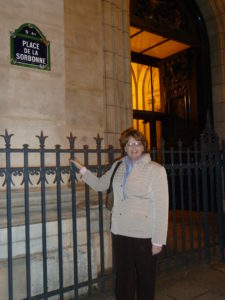I’ve been mulling over writing this story for a long time. I had many letters from 1944-1945 my mother had written home, so I knew I could use those as the outline of the story. But some of the material was personal, like her love life, and did I want to splash all that over a book?

In the end, I decided I did because you can’t have a good novel about straight war work, even propaganda war work. There have to be a few problems and additional characters along the way. A few things, including all the names of the characters in the story, except for the people who worked at OWI, were changed.
I then asked myself if I thought my mother would want me to write this story. With her death in 2006, the opportunity to talk with her about the idea of a book was long gone. But, as we were going through their possessions after they had both passed away, we found my mother’s yearly date calendars. I looked through them casually, ready to discard them, until I caught an entry in the 1990 calendar.
“Greenwich Library – Write Your Memoir Class, 8pm”
Once I saw that, I realized she herself had at least thought about getting this story down on paper. One of my constant companion’s was the question, would my mother want me to write this story? I just loved the war information part and felt that her personal experiences, were also interesting and fun. In the end, I decided that permission had been granted. My siblings agreed.
I started an earlier version of the book with short paragraphs explaining each letter, but I craved narrative and historical information around the letters. Talking about London in 1944 with authenticity required some serious research. My first deep dive was to look into Shepherd Market, where she lived. I was thrilled to understand the rich history behind that little neighborhood, and so I weaved in as much as I could about this small section of Mayfair. Mom loved living there.
On just about every page of the book, the need for historical accuracy popped up like daffodils in spring. First, there were the daily life questions, then the work-related questions. What was the OWI doing exactly? What was my mother’s precise role at OWI? Were there communists in the OWI?
Were there cabs running in London in 1944 and 1945? What about in Paris in 1945? How would someone get from Paris to Reims without a car and if the trains weren’t running during the Occupation? Was there in-country mail service in France during the Occupation? What exactly was happening in the battlefield in Belgium on November 18, 1944? These are all snap questions for trained historians, but I was doing the heavy lifting with a BA in Journalism.
While some of these were easier to sort out than others, the fun of it all was to track down the answers in the research. It is one of the major reasons this endeavor has taken me a while to finish. When a question came up, it would sometimes lead to a three-hour search in the abyss of the internet, trips to the library, phone calls to reference librarians, requests for personnel files and outreaches to a few colleges for more information.
Trips were also involved. It’s one thing to go to a foreign country and sight-see. It’s a whole other kettle of fish to look for specific addresses and try and recreate a time and place experience. I loved searching out the spots, taking notes and then snapping a picture.

There were trips to the Library of Congress in Washington, DC and the National Archives in College Park, MD, both amazing repositories of historical documents, recordings, pictures and so much more. There was a great deal of compelling information. I came home with far more than I ever could have used and as it is, the book is content rich as it relates to the OWI material.
The greatest joy was amalgamating the field knowledge, the archival content, book resources and internet research to create a fairly accurate backdrop for the main event: telling the story of my mother’s wartime experience.
